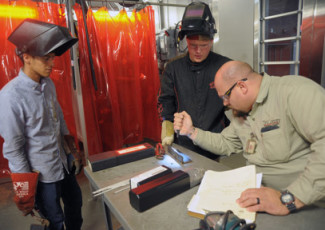Workforce Development That Unites Families, Reduces Crime
By Dennis Pierce
March 7, 2016
How one college in Connecticut created a prison education program that restarts students’ lives.
Prisoner education programs aren’t new to community colleges. Last year, for example, California rolled out more tools and courses that help state community colleges provide instruction to prison inmates. While that pilot program is new, one on the East Coast, in Connecticut, has garnered attention for its success, helping more than 2,000 incarcerated parents reunite with their children and find jobs with more than 100 employers over the past two decades.
Quinebaug Valley Community College (QVCC), which started the STRIDE (Skills, Transition, Respect, Integrity, Direction, Employment) program 17 years ago, is home to this award-winning workforce-development program, though the courses are taught at five correctional facilities.
To be eligible for the program, an inmate must have a child under the age of 25, who has received services from the Department of Social Services. QVCC makes new inmates aware of the program during orientation. Classes serve from 15 to 25 inmates at a time; currently, there is a waiting list of applicants.
What do prisoners need in order to get a job?
The 10-week curriculum teaches participants key employability skills, such as how to write a resume, how to act during a job interview and how to discuss their incarceration with potential employers. Classes meet twice a week for two hours each session. Students also meet regularly with a career specialist to set goals, discuss aspirations and conduct mock interviews.
Once released, students receive resumes and portfolios of their work, and a flash drive that contains these items in electronic form; a bus pass; and a clothing voucher, so they can buy work-appropriate attire. A job developer meets with the students at regular intervals for up to a year, helping them to find work.
“Our job developers work throughout the state to find employers who will hire ex-offenders,” says director Julie Scrapchansky. “We try to establish and maintain relationships with employers to make sure it’s a proper fit, so that individuals are going to the right organization and using the transferable skills they might have.”
Selling drugs, for instance, requires sales skills that can transfer to “selling cars, or telemarketing,” she says. “We want participants to realize they don’t have to sell drugs.”
The program’s holistic approach, encompassing both pre- and postrelease services, is a key to its success. Statewide, the rate of recidivism among ex-inmates who have not experienced a re-entry program is 47 percent; for STRIDE participants, it’s only 8 percent.
The program is funded through the state Department of Labor. Funding has fluctuated throughout the years; it has been as high as $770,000 but stood at $518,000 in the last fiscal year, Scrapchansky says. QVCC also has partnered with the state’s Department of Corrections and Department of Social Services.
QVCC’s key takeways
Building relationships with state legislators is important to the success of a program like STRIDE. “Testify at appropriations hearings, and get your results out to as many people as possible,” Scrapchansky advises. “Timely reporting to funders and the people you’re beholden to is critical.”
Also, be flexible in responding to changes in funding or facilities. “You have to be really flexible in starting out, knowing there will be many changes and obstacles that you’re going to come across,” she says.
Once your program is established, “it’s about managing and growing relationships with your partners,” she says. “And make sure you work collaboratively with them.” For instance, Scrapchansky and her staff participate in state workforce-development councils to forge strong relationships with area employers.








